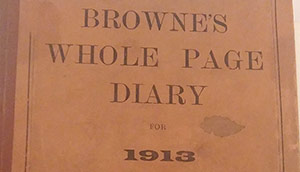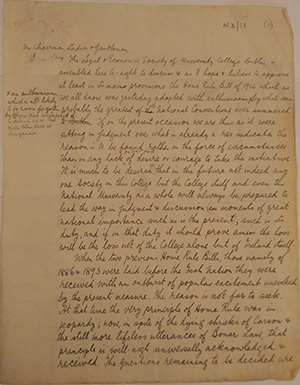Arthur Cox: witnessing history

eolas takes a look at leading law firm founder Arthur Cox’s life and his involvement in key historical events 100 years ago.
Arthur Cox was a strong supporter of the Irish Parliamentary Party and Home Rule. Educated at Belvedere College and University College Dublin, he led a remarkable academic career. His contemporaries during these years went on to hold prominent positions in government including Kevin O’Higgins, John A. Costello and Patrick McGilligan. Cox was a friend, confidant and adviser to many of the founders of the Irish Free State.
Arthur Cox’s 1913 diary extracts (see box) reveal his interest in Home Rule as he tracked the Bill through the Houses of Parliament. A speech Cox gave at UCD shows that he was willing to accept a limited version of Home Rule and was satisfied with the contents of the Bill. However, he was not too impressed with the fact the Irish Parliament could not enact any laws interfering with religious equality, observing that “instead of intolerance, tolerance run mad is to be anticipated”.
Representing Áine Ceannt
Áine Ceannt was the widow of Eamonn Ceannt, one of the leaders of the 1916 Rising. She was also vice-president of Cumann na mBan and one of the founders of the Irish White Cross. The Irish White Cross was a charitable organisation set up in 1920 to relieve the distress of the civilian population after the arrival of the Black and Tans. Arthur Cox & Co acted as solicitors to the Irish White Cross. Arthur personally advised Ceannt on her role as secretary and trustee of the association.
After the War of Independence a number of Decrees for Compensation for Criminal Injury to Property were granted by the county courts. With no immediate prospect of payment, the Irish White Cross provided advances in the forms of loans. The Arthur Cox archives house over 100 copies of these decrees for compensation. The decrees outline atrocities committed by the Black and Tans and the Irish Republican Army across the country during the War of Independence.
An account in the book “Prison Letters of Countess Markievicz” written by Esther Roper stated that Captain Colbert, who served under Commandant Eamonn Ceannt during the 1916 Rising, offered to take Ceannt’s place and give their battalion’s surrender to the British as he was a “single man”. Allegedly Ceannt refused but was deposed and Colbert gave the surrender and was subsequently tried and shot.
Cox, on Áine Ceannt’s behalf, contested this version of events. In his letter to the publishers, Longman Green & Co, he stated that: “the story has no foundation whatsoever and its publication is a serious slur on the courage and honour of the late Commandant Eamonn Ceannt… There are at least 100 men still living who can testify to the fact that Commandant Ceannt marched at the head of his Battalion to St Patrick’s Park and there personally ordered his men to down arms.” Roper later issued a full apology.
Advising on the Treaty
Hugh Kennedy was legal advisor to the Provisional Government and attended the Treaty negotiations in London. In 1922 he became the first Attorney General and the first Chief Justice of the Irish Free State. Kennedy acted as Chief Justice of Ireland until his death in 1936. In 1922, he sought Cox’s opinion on the Treaty, he argued that the Articles of Agreement of 6 December 1921 ended the right of Britain to legislate for Ireland and throughout the opinion emphasised the sovereignty of the Irish people.
Arthur’s opinion
“The opposition to the Treaty in Ireland… in so far as it is based on sound reasoning at all, proceeds apparently on the argument that the Treaty is not a Treaty of External Association but is a Treaty representing nothing more than an informal agreement between certain members of the British Cabinet and certain delegates from Ireland and accordingly that it does not constitute a firm foundation for the future independence of Ireland, or for the future good relations between Ireland and England.
Any claim by the British Parliament to legislate further for Ireland represents an encroachment of and an attack upon the liberties of Ireland and as such should be resisted to the utmost, even if it should lead to a direct hitch with the British Government and a renewal of hostilities, because to give way upon this point would be to give way upon the whole.”

Arthur’s diaries extracts
7 February 1913: Protesting against the action of the House of Lords
At the meeting in Mansion House to protest against action of House of Lords in throwing out Home Rule. Great demonstration… Finished Pollock’s Torts (1796)
7 July 1913: Passage through the House of Commons
Carried Third reading of Home Rule Bill on its second passage through the House of Commons is carried by a majority of 109. Hurrah! (The majority was 110 last time)
 15 July 1913: House of Lords reject the Bill
15 July 1913: House of Lords reject the Bill
The Lords reject the Home Rule Bill on the second night of the debate. The majority against it was 19 less than on the previous occasion. There is now a clear course before the Bill on its 3rd passage. The House of Lords is no longer an obstacle. 319 days more.
Speech on home rule
“When the two previous Home Rule Bills, those namely of 1886 and 1893 were laid before the Irish nation they were received with an outburst of popular incitement unevoked by the present measure. The reason is not far to seek. At that time the very principle of Home Rule was in jeopardy; now, in spite of the dying shrieks of Carson and the still more lifeless utterances of Bonar Law, that principle is well-nigh universally acknowledged and received…”





